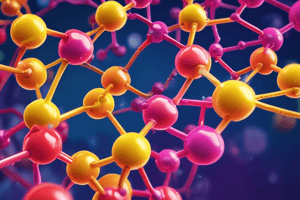Podcast
Questions and Answers
What is the effect of increasing the surface area of reactants on the reaction rate?
What is the effect of increasing the surface area of reactants on the reaction rate?
It increases the reaction rate.
What is the role of a catalyst in a chemical reaction?
What is the role of a catalyst in a chemical reaction?
To increase the reaction rate without being consumed by the reaction.
What is the term for the minimum energy required for a reaction to occur?
What is the term for the minimum energy required for a reaction to occur?
Activation energy.
What is the difference between a fast reaction and a slow reaction?
What is the difference between a fast reaction and a slow reaction?
Signup and view all the answers
What is the term for a reaction that is accelerated by the presence of a catalyst?
What is the term for a reaction that is accelerated by the presence of a catalyst?
Signup and view all the answers
Study Notes
Organic Compounds
Definition
- Organic compounds are chemical compounds that contain carbon and hydrogen atoms, and may also contain other elements such as oxygen, nitrogen, and sulfur.
- They are typically found in living organisms and are the basis of life.
Characteristics
- Covalent bonds: Organic compounds are formed through covalent bonds between atoms.
- Carbon skeleton: Organic compounds have a carbon skeleton, which is the backbone of the molecule.
- Functional groups: Organic compounds have functional groups, which are specific groups of atoms that determine the molecule's chemical properties.
- Isomerism: Organic compounds can exhibit isomerism, which is the existence of two or more molecules with the same molecular formula but different structures.
Types of Organic Compounds
- Hydrocarbons: Contain only carbon and hydrogen atoms.
- Saturated hydrocarbons: Have only single bonds between carbon atoms.
- Unsaturated hydrocarbons: Have one or more double or triple bonds between carbon atoms.
- Functional groups: Include alcohols, aldehydes, ketones, carboxylic acids, and amines.
Chemical Kinetics
Definition
- Chemical kinetics is the study of the rates of chemical reactions and the factors that affect them.
Factors Affecting Reaction Rate
- Concentration: Increasing the concentration of reactants increases the reaction rate.
- Temperature: Increasing the temperature increases the reaction rate.
- Surface area: Increasing the surface area of reactants increases the reaction rate.
- Catalysts: Substances that increase the reaction rate without being consumed by the reaction.
- Activation energy: The minimum energy required for a reaction to occur.
Reaction Rate Equations
- Rate of reaction: The change in concentration of reactants or products per unit time.
- Rate constant: A constant that describes the rate of reaction.
- Rate equation: An equation that describes the rate of reaction as a function of concentration and rate constant.
Types of Reactions
- Fast reactions: Reactions that occur quickly, often in a matter of seconds.
- Slow reactions: Reactions that occur slowly, often over a period of minutes or hours.
- Catalytic reactions: Reactions that are accelerated by the presence of a catalyst.
- Inhibitor reactions: Reactions that are slowed down by the presence of an inhibitor.
Organic Compounds
- Contain carbon and hydrogen atoms, and may also contain other elements such as oxygen, nitrogen, and sulfur.
- Typically found in living organisms and are the basis of life.
Characteristics
- Formed through covalent bonds between atoms.
- Have a carbon skeleton, which is the backbone of the molecule.
- Have functional groups, which determine the molecule's chemical properties.
- Can exhibit isomerism, where two or more molecules have the same molecular formula but different structures.
Types of Organic Compounds
- Hydrocarbons: Contains only carbon and hydrogen atoms.
- Saturated hydrocarbons: Have only single bonds between carbon atoms.
- Unsaturated hydrocarbons: Have one or more double or triple bonds between carbon atoms.
- Functional groups: Include alcohols, aldehydes, ketones, carboxylic acids, and amines.
Chemical Kinetics
- Study of the rates of chemical reactions and the factors that affect them.
Factors Affecting Reaction Rate
- Concentration: Increasing the concentration of reactants increases the reaction rate.
- Temperature: Increasing the temperature increases the reaction rate.
- Surface area: Increasing the surface area of reactants increases the reaction rate.
- Catalysts: Substances that increase the reaction rate without being consumed by the reaction.
- Activation energy: The minimum energy required for a reaction to occur.
Reaction Rate Equations
- Rate of reaction: The change in concentration of reactants or products per unit time.
- Rate constant: A constant that describes the rate of reaction.
- Rate equation: An equation that describes the rate of reaction as a function of concentration and rate constant.
Types of Reactions
- Fast reactions: Reactions that occur quickly, often in a matter of seconds.
- Slow reactions: Reactions that occur slowly, often over a period of minutes or hours.
- Catalytic reactions: Reactions that are accelerated by the presence of a catalyst.
- Inhibitor reactions: Reactions that are slowed down by the presence of an inhibitor.
Studying That Suits You
Use AI to generate personalized quizzes and flashcards to suit your learning preferences.
Description
Explore the basics of organic compounds, including their definition, characteristics, and properties. Learn about covalent bonds, carbon skeletons, and functional groups.




